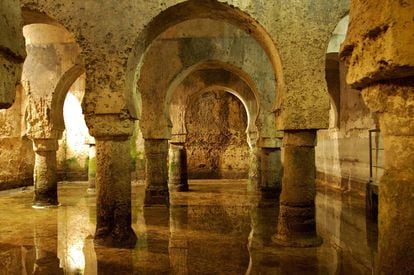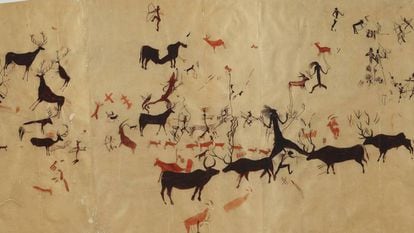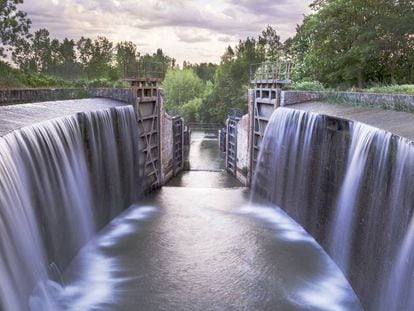Secret Spain: little-known sites that are well worth a visit
Whether natural or man-made, these striking locations receive a fraction of the visitors they deserve

1. Veletas Palace water deposit (Cáceres)
Sitting beneath the Renaissance-era courtyard of Veletas Palace (15-17th century) which today houses the Cáceres Museum, is the largest aljibe, or water deposit, created in Spain under Arab rule. Heir to the grand byzantine reservoirs of Constantinople, it is 14 meters long and 10 meters wide, and built between the 10th and 11th centuries using recycled materials from old Roman and Visigoth structures. The space is supported by horseshoe columns that are reflected over the water’s surface under a misty, golden light.

2. Forts of Cerro del Puerco (Valsaín, Segovia)
The top of the “Cerro del Puerco”, (altitude 1,421 meters), a hill in the Valsaín mountains with marvelous views of the Guadarrama range, is also home to some of the best-conserved forts, tunnels and trenches of the Spanish Civil War. This was also the site of one of the toughest battles during the Republican offensive of May 1937, between the 14th International Brigade and the defending Falange troops. This cruel battle, in which there were over a thousand casualties, barely changed the rivals’ positions, and the hill remained under rebel control. The circular trail to Cerro del Puerco (5.5 kilometers) starts at the La Pradera de Navalhorno sawmill (Valsaín), near La Granja de San Ildefonso, and follows the right side of the forest path that runs through the pine groves towards Peñalara mountain (altitude 2,428 meters).

In the highland moors of Molina de Aragón, an impressive red fortress can be found doing a balancing act over a sharp cliff of the same color. It is a perfect landscape to recreate the Tower of Joy of Dorne, where Ned Stark watched his sister Lyanna die in Game of Thrones. Built in the 12th century, it belongs to the municipality of Campillo de Dueñas, although it is usually accessed through Hombrados, 25 kilometers away from Molina de Aragón.

4. Beach of Silence (Cudillero, Asturias)
The music that the pebbles create follows the rhythm of the ebb and flow of the waves on the beach of Silence, 16 kilometers to the west of Cudillero. This is a sandbank for lovers of peace and quiet, of green landscapes and cliffs. It can be reached on foot from the town of Castañeras, on a steep descent (and afterwards, ascent) through a dirt path and a staircase of over 100 steps.

5. ‘Pedra en Sec’ trail (Mallorca)
One of the distinguishable marks of the Tramuntana mountain range in Mallorca, is the pedra en sec (or dry rock), a traditional construction technique which uses the loose rocks of the countryside, without mortar, to erect walls between plots of land; build shacks and kilns, or pave mountain roads such as the Pedra en Sec trail GR-221, the first long-distance trail in the Balearic Islands, which has over 160 kilometers of guided paths with hostels for overnight stays between legs of the trip.

About 30 kilometers south of Cuenca, immersed in the spectacular setting of the Gritos River gorge, are the ruins of Valeria, a Roman city founded in the year 93 B.C. and which, unlike the nearby Segóbriga, is almost unknown. Its nymphaeum, a 105-meter long gallery with alcoves filled with statues depicting Roman deities, was the most important of Hispania and one of the largest of the entire Roman Empire.

7. Santa María de Cárdaba shrine (Valtiendas, Segovia)
Next to the road that connects the towns of Pecharromán and Sacramenia, in the north of Segovia province, a small pre-Romanesque church emerges (9-10th century) which was once part of the Benedictine monastery of Santa María de Cárdaba, which was donated by the Count of Castile Fernán González to San Pedro de Arlanza monastery in Burgos, in the year 937. Like all medieval priories, it was dedicated to agriculture. Among the crops there were grapevines, as recorded in the monasterial accounts between the years 1337-1338, when the annual production of the vineyard reached 100 amphorae of wine. In 1488 it came under the control of the Cistercian monks of the neighboring Santa María la Real de Sacramenia monastery. Following the sale of Church assets by the government in 1835, it became private property. Today it holds the vineyards and winery of Finca Cárdaba (there are tours with with wine tastings for €6-10 per person).

The name of this forest comes from the Galician expression auga que ferve (water that boils), because of the waterfalls that are created during the periodic rise of the waters of the Miño River in one of the most beautiful riverside forests in all of Galicia, located 15 kilometers from Lugo. Two hiking trails (one of them starts out in Lugo) uncover an aquatic landscape rich with oak, willow and ancient alder trees. A rural hotel, Fervenza Casa Grande, rents out rooms (starting at €50 a night), canoes and bicycles.

9. Cave paintings of La Vieja (Alpera, Albacete)
The prehistoric cave paintings of Spain’s Levante area, an extraordinary pictorial manifestation that cannot be found anywhere else in Europe, have one of its most emblematic enclaves in La Vieja cave, a rock shelter about four kilometers away from Alpera, in Albacete province. There are over 200 red figures, drawn with bird feathers that depict archers, shamans, dancing women, goats, stags and geometric shapes on a tremendous frieze that dates back to the Epipaleolithic era, around 6,000 B.C.

10. National Anthropology Museum (Madrid)
A chamfered mansion between Atocha train station and Retiro Park holds this curious museum, founded in 1875 as the Museum of Anatomy by Dr Pedro González Velasco, who invested all of his savings into its construction and later filled it with his precious private collection of anatomical objects obtained from various scientific expeditions. Besides an interesting ethnological catalogue that includes pre-Columbian mummies, shrunken heads, canoes and weapons, the exhibit also holds the skeleton of Agustín Luengo, dubbed the Giant of Badajoz. Luengo, who suffered from acromegaly, a disease that stunts growth, sold his body to the doctor in exchange for 3,000 pesetas and a daily wage until he died. According to Madrid legend, the doctor was so obsessed with the topic of mummification as a means to reach immortality that when his own daughter Conchita died, he embalmed the corpse and lived with the mummified body until his own death, propping her up at the table and driving her around in his car through the streets of Madrid.
English version by Laura Rodríguez.













































